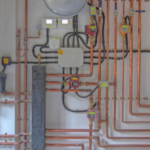11 Reasons why your building isn’t prepared for winter 2019
Research has found over 30% of organizations fail to plan for the winter… Resulting in lost productivity, revenue and costly repairs later down the line
According to the EPA, Energy represents a significant proportion of operating expense in commercial properties, and the energy waste via facilities flaws can cost you even more during the winter months….
Alternating periods of cold and warm weather, frost and water damage can lead to costly repairs and energy leaks on a large scale. Your goal is to eliminate wasted energy throughout the winter months to maintain a more economically sustainable and efficient building, starting today.
1. Your Entrance & Exit doors open flush to the outdoors resulting in cold, moist air drafts regulating the temperature and air quality of your facility.
2. There are signs of frost around exterior walls, indicating draft or insulation issues, resulting in wasted energy.
3. Your flat roof hasn’t had regular inspection and maintenance. This can pose a big problem during the winter as heavy snow or ice can pile up and cause damage to the surface or structural integrity of the building (make a plan for snow removal on flat roof surfaces to avoid these repercussions).
4. Your slanted roof vents and shingles haven’t been inspected before the snow falls.
5. You don’t have properly installed power surge protectors or adequate off-site file back-ups which removes the immediate risk of data loss when their’s a strong storm or high winds. Ensure that power to critical systems stays working with generators during power outages, and keep your building protected.
6. Your heating systems aren’t set to turn on regularly so pipes can be warmed and don’t freeze and burst.
7. You haven’t considered both preventative and responsive measures to winter fire safety:
• Have an electrical contractor run tests on ‘last mile’ connections throughout the facility to check wiring and loads placed on outlets, panels, and equipment.
• Supply adequate heat to keep fire response equipment functioning efficiently and prevent freezing (think fire protection tanks, value houses, water tanks, pump houses etc)
8. Your sprinkler systems aren’t mapped along with low point drains and are not protected from the cold air so your pipes freeze.
9. Your gas lines and connections aren’t corrosion-free to prevent breakdown and eliminate underground pipe threads
10. You haven’t provided clear snow removal instructions to your contractor to minimize any unexpected inconvenience or safety risk snow may cause to your building and staff.
11. Your gutters haven’t been cleaned thoroughly or tested to be sure water does not back up. The cold weather can escalate any unresolved deterioration or blockages, and repair costs will be far greater than that of maintenance.
Developing a planned winter maintenance program with the help of a trustworthy supplier enables you to create a reliable way for your organization to cope with the unpredictability of winter, making you prepared for both the immediate and long-term effects of severe weather, whilst ensuring an energy efficient building and optimal staff safety.
#staycompliant #costdown #energyefficiency







